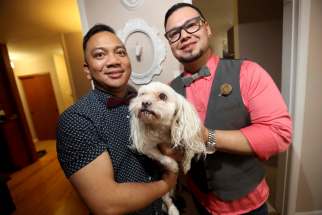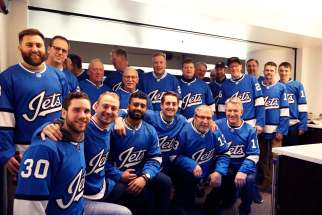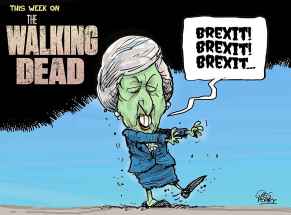In a Barbie world As Mattel 'role model,' Cree filmmaker/author empowers Indigenous people, challenges stereotypes
Read this article for free:
or
Already have an account? Log in here »
To continue reading, please subscribe:
Monthly Digital Subscription
$0 for the first 4 weeks*
- Enjoy unlimited reading on winnipegfreepress.com
- Read the E-Edition, our digital replica newspaper
- Access News Break, our award-winning app
- Play interactive puzzles
*No charge for 4 weeks then price increases to the regular rate of $19.00 plus GST every four weeks. Offer available to new and qualified returning subscribers only. Cancel any time.
Monthly Digital Subscription
$4.75/week*
- Enjoy unlimited reading on winnipegfreepress.com
- Read the E-Edition, our digital replica newspaper
- Access News Break, our award-winning app
- Play interactive puzzles
*Billed as $19 plus GST every four weeks. Cancel any time.
To continue reading, please subscribe:
Add Free Press access to your Brandon Sun subscription for only an additional
$1 for the first 4 weeks*
*Your next subscription payment will increase by $1.00 and you will be charged $16.99 plus GST for four weeks. After four weeks, your payment will increase to $23.99 plus GST every four weeks.
Read unlimited articles for free today:
or
Already have an account? Log in here »
Hey there, time traveller!
This article was published 18/01/2019 (2516 days ago), so information in it may no longer be current.
When Mattel reached out to Cree filmmaker and writer Sonya Ballantyne about being one of 60 Canadian Barbie Role Models to commemorate the iconic doll’s 60th birthday in 2019, her initial reaction was “why me?”
Ballantyne, 33, doesn’t exactly love being the centre of attention. Heck, she didn’t even really play with Barbies as a kid in the ’90s, save for her sister’s SeaWorld Barbie. “I thought she was a marine biologist, which is what I wanted to be,” she says. “I thought it was cool she had a whale she trained and took care of.”
But the more Ballantyne reflected on being named a Barbie Role Model, the more she realized it was an opportunity. Growing up in Misipawistik Cree Nation in northern Manitoba, she didn’t see herself on TV, or in movies, or in her little sister’s blond-haired Barbie dolls. Challenging stereotypes and providing positive, empowering representations of Indigenous people has been a major through-line in her work as a filmmaker and, now, as an author. In November, she published her first children’s book, Kerri Berry Lynn, about a very special little Cree girl and her loyal pack of seven dogs.
“I didn’t have a hero as a kid who looked like me and I don’t want other kids to grow up with that, so I will put aside any discomfort I have being in a public forum to make sure kids have that person,” she says. “After I processed it, I’m really thankful they chose me. I want native kids to grow up with the drive and knowledge in their own humanity that is often taken away from them when they’re young.”‘I didn’t have a hero as a kid who looked like me and I don’t want other kids to grow up with that, so I will put aside any discomfort I have being in a public forum to make sure kids have that person’
As word got out about Ballantyne’s position as Barbie Role Model, Indigenous girls (and a few women) started asking her when she’d “get her own Barbie.” “I almost cried when I did a reading at Strathcona School — which is a primarily an Indigenous school in Winnipeg — and a little girl told me, “if they make a Barbie of you, I’m going to buy it right away.’”
Ballantyne’s “why me?” turned into a “why not me?” and now, she’s organized a Change.org petition, asking Mattel to create the first Cree Barbie. It has more than 1,300 signatures; actor Vincent D’Onofrio, a personal hero of Ballantyne’s, even tweeted his support for her campaign with the hashtag #SonyaRocks.
Ballantyne has a specific vision for her Cree Barbie. She doesn’t want to see a generic ‘native American’ doll; she wants a doll that has a specific nation — in this case, Cree — assigned to her. She’d also love to see an Indigenous doll that wasn’t dressed in buckskin or regalia, but rather dressed as a modern Cree girl.
“I’d want her to wear mukluks, jeans, and a T-shirt. I was teasing my friends by saying I wanted the T-shirt that had a fry container with feathers that said ‘Fries Before Guys,’ but I’d want to shout-out my favourite character, Lisa Simpson, who also had her own doll made. The doll said, ‘Trust in yourself and you can achieve anything.’ I’d want it to say that.”

In her 60-year history, Barbie has been both praised and criticized when it comes to the example she sets for girls. She went from being a miniature mannequin meant to model outfits to an impressive career woman meant to show girls that they could be anything — a vet, a doctor, an astronaut, a firefighter, a pilot, a ballerina, a chef, a rock star.
Still, while her clothes, professions, and even her face changed over the years, Barbie remained unflinchingly Barbie: blond hair, tiny waist, large bust, white skin. The message “you can be anything” seemed to come with an implied asterisk: *so long as you look like Barbie.
Now, Mattel’s flagship doll is offered in expanded body sizes, heights, skin tones, and hair textures. A Cree Barbie, as Ballantyne has envisioned it, seems like it would fit right in. For Mattel’s part, a spokesperson offered this statement: “Barbie continues to honour a diverse group of role models who break boundaries to inspire the next generation of girls. We are proud to partner with Sonya and share her message. Barbie continues to evolve and currently offers the most diverse doll line on the market.”
Whether Cree Barbie joins that line remains to be seen, but Ballantyne believes her existence would mean a lot to kids who are still growing up like she did.
“There’s still an anti-Indigenous ribbon that runs through everything in Canada,” Ballantyne says. “The idea the world I grew up in as a kid is still the world my nephews are growing up in. The second my nephew is not cute anymore, he’ll be mistreated because he’s a native boy, or these native girls being sexualized because that’s what native girls are. That drives me nuts. Advocating for the Barbie is me just wanting to prove that a native Barbie from Mattel would be encompassing the message of you can be anything.”‘There’s still an anti-Indigenous ribbon that runs through everything in Canada. The idea the world I grew up in as a kid is still the world my nephews are growing up in. The second my nephew is not cute anymore, he’ll be mistreated because he’s a native boy, or these native girls being sexualized because that’s what native girls are. That drives me nuts’
And yes, Ballantyne would have played with Cree Barbie.
“I would have thought that was the coolest thing,” she says. “I used to freak out over any Cree representation. I remember when Tom Jackson was on Star Trek: The Next Generation and it was basically like me being on Star Trek: The Next Generation. I still freak out over Cree people doing cool things.”
Now that she’s the one doing cool things, she hopes she can inspire the upcoming generation of Indigenous kids to be whatever they want to be.
“I came from a rez and there were so many obstacles in my way to get anywhere and do anything at all,” she says. “It was very difficult, but I did it. And if that gives you the drive to know you can do it too, that’s what this represents.”
jen.zoratti@freepress.mb.ca
Twitter: @JenZoratti

Jen Zoratti is a Winnipeg Free Press columnist and author of the newsletter, NEXT, a weekly look towards a post-pandemic future.
Our newsroom depends on a growing audience of readers to power our journalism. If you are not a paid reader, please consider becoming a subscriber.
Our newsroom depends on its audience of readers to power our journalism. Thank you for your support.








